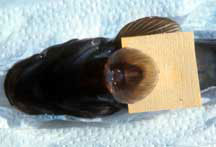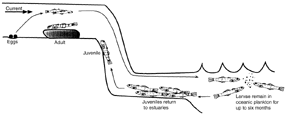Adaptation
Adaptations of Hawaiian Freshwater Gobies to Stream Life
The five native fishes found in Hawaiian streams are well adapted to their highly energetic, sometimes violent, and ever changing environment. The surprisingly low number of freshwater fishes is probably an indication of the difficulties associated with living in the Hawaiian stream habitat. Upon closer examination, we can identify some of the adaptations that were necessary to ensure the survival of each species in the Hawaiian streams. Adaptations are structures or features unique to a species, or a group of species, which allow them to survive and reproduce in a specific habitat. Adaptations are the results of two evolutionary processes: random mutation in the genetic code (DNA) of an animal and natural selection through the environment of a species. Random mutations create structural changes in an animal and natural selection will determine whether these changes increase or decrease an animals chances to survive, reproduce, and to pass on the genetic changes to its offspring.
One important adaptation found in all five species of Hawaiian freshwater fishes are their amphidromous migrations (see illustration at left). Amphidromy describes a life cycle, that includes two migrations, usually one downstream and one upstream, that are not directly related to reproductive events. Larvae are washed out into the ocean right after hatching and live in the oceanic plankton for three months, or in the case of Sicyopterus stimpsoni (‘o‘opu nōpili) up to six months. Larvae (hinana) return in large numbers into the streams, often after flash floods have created large freshwater plumes that extend far into the ocean. This amphidromous life cycle is a crucial adaptation for the survival on an oceanic island where the stream environment is often subjected to catastrophic events such as hurricanes, flashfloods, and lava flows. The larvae in the ocean provide a reservoir for each species to repopulate streams after such catastrophic events. In addition, larvae are also moved by ocean currents to other streams and even islands, which ensures dispersal and maintains a complete gene pool.
 The larvae face a hostile environment when returning to the estuary. Larvae are behaviorally adapted to overcome the pounding surf at the mouth of most streams, by either using the wave action of the incoming tide, or by swimming actively swimming through the tidal zone. A related behavioral adaptation is the strong urge of all of these larval fish to stream against current. This was used in earlier times to catch hinana in traps facing downstream. Once in the estuary fish are preyed upon by a large number of marine and freshwater fishes. Once in the estuaries each species employs a different survival mechanism. Larvae of Eleotris sandwicensis and Stenogobius hawaiiensis (‘o‘opu naniha) will remain in the estuaries for the rest of their life as they are not capable of climbing the waterfalls, which often obstruct the passage into the upper stream reaches. Awaous guamensis (‘o‘opu nākea), Lentipes concolor (‘o‘opu ‘alamo‘o), and S. stimpsoni will pass through the estuaries and are adapted to climb waterfalls to reach their adult habitats. Once past the terminal waterfall these three species will separate over the remainder of the stream according to their climbing ability. A. guamensis will remain in the lower to mid stream reaches, S. stimpsoni will climb into the mid stream reaches, and L. concolor can be found above even the highest waterfalls of Hawai‘i.
The larvae face a hostile environment when returning to the estuary. Larvae are behaviorally adapted to overcome the pounding surf at the mouth of most streams, by either using the wave action of the incoming tide, or by swimming actively swimming through the tidal zone. A related behavioral adaptation is the strong urge of all of these larval fish to stream against current. This was used in earlier times to catch hinana in traps facing downstream. Once in the estuary fish are preyed upon by a large number of marine and freshwater fishes. Once in the estuaries each species employs a different survival mechanism. Larvae of Eleotris sandwicensis and Stenogobius hawaiiensis (‘o‘opu naniha) will remain in the estuaries for the rest of their life as they are not capable of climbing the waterfalls, which often obstruct the passage into the upper stream reaches. Awaous guamensis (‘o‘opu nākea), Lentipes concolor (‘o‘opu ‘alamo‘o), and S. stimpsoni will pass through the estuaries and are adapted to climb waterfalls to reach their adult habitats. Once past the terminal waterfall these three species will separate over the remainder of the stream according to their climbing ability. A. guamensis will remain in the lower to mid stream reaches, S. stimpsoni will climb into the mid stream reaches, and L. concolor can be found above even the highest waterfalls of Hawai‘i.

Sucking disk on A. guamensis
On their way to the adult habitats A. guamensis and L. concolor spend little time in the estuary and will climb the terminal waterfall as soon as they have past through the estuary, thus escaping the predatory pressure as quickly as possible. They do so by using their pelvic sucking disk (see photo at left), a structure commonly found in tidal zone gobies, which allows the fish to anchor themselves to substrate in the tidal wave environment. A. guamensis and L. concolor anchor themselves to the surface of the waterfall after advancing by very powerful swimming motions. Thus, the pelvic sucking disk, which can be seen as an adaptation to the tidal zone environment, becomes a pre-adaptation for climbing waterfalls. The pelvic sucking disk is also an adaptation useful in their adult habitat, where the fish frequently maintain position, by attaching to a rock with their pelvic sucking disk. S. stimpsoni will remain in the estuary for approximately 36 hours before climbing the terminal waterfall. The delay is due to the fact that S. stimpsoni is apparently unable to climb waterfalls by using swimming motions and its pelvic sucking disk alone. During the 36 hours following the fishes arrival in the estuary it will undergo an amazing metamorphosis which constitutes perhaps the most striking adaptation of all Hawaiian freshwater fish.. The metamorphosis in S. stimpsoni may be one of the fastest and most complete such events found among all vertebrates. During the metamorphosis the mouth will shift from its larval position at the front of the head, to a position in line with the underside of the fish (ventral). The upper lip will increase greatly in size during the metamorphosis and will be used as a second sucking disk during climbing. Once the metamorphosis is completed, S. stimpsoni will climb out of the estuary by an alternating attaching and releasing of its pelvic sucking disk and sucking mouth. The fish will literally “inch” its way out of the estuary and the predators harm. Once in its adult habitat the ventrally positioned mouth is well adapted to scrape diatoms from the surface of rocks, while the fish is holding on with its pelvic sucking disk.
Many more adaptations certainly exist in these fish in order to ensure their survival in Hawaiian freshwater streams. The few examples given here may illustrate the immense barriers that have prevented more species of fish to colonize the Hawaiian freshwater system.
Learn more about the O‘opu nōpili and the anatomy of its hinana (PDF)
Photo and Illustrations: Heiko L. Schoenfuss and Division of Aquatic Resources

